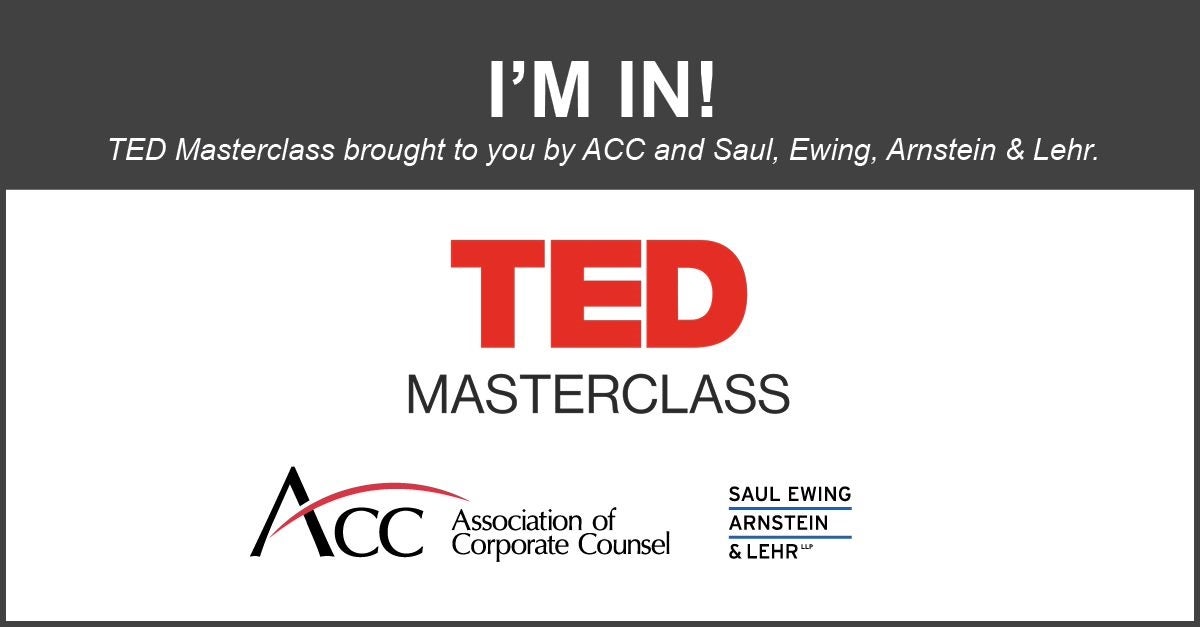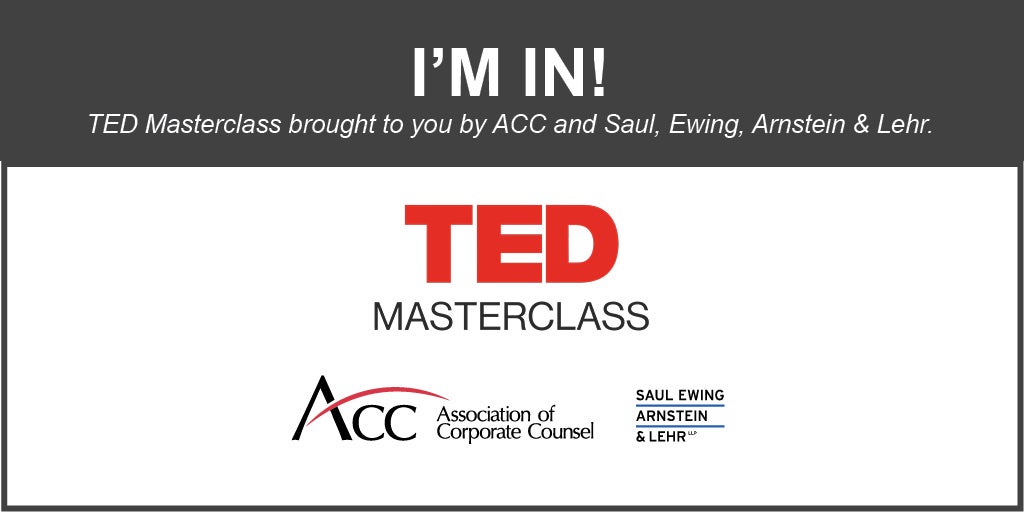2021 ACC TED Masterclass Tips
Stage 1 Tips from TED
Here are some tips to keep in mind as you identify and develop your ideas in Stage 1, Lesson 3.
Tip 1: Don’t worry, throughlines will evolve!
Even our best, most seasoned TED speakers go through a highly iterative throughline development process. You will be able to (and likely should) come back to your throughline as many times as you feel is necessary during the course (including in Stages 2 and 3).
Tip 2: Use checkpoints to get to a clear, compelling, unique throughline.
Beware of vague, superficial, and especially cliche throughlines. “Live life to the fullest” is a cliche, not a throughline!
Here’s an example of what your throughline iteration could look like using the checkpoints:
- First draft: “The importance of starting over.”
- Checkpoint 1: Your throughline should be a tool, not a pithy title
- Draft after Checkpoint 1: “Learning how to start over can make or break your ability to succeed.”
- Checkpoint 2: Your throughline should reflect your personal experience & credibility on the subject
- Drafts after Checkpoint 2: “I wouldn’t have made it where I am today if I hadn’t developed the skill of starting over. I experienced a traumatic brain injury as a teen and had to learn how to do everything all over again.”
- Checkpoint 3: Your throughline should include an element of something new or unexpected
- Drafts after Checkpoint 3: “Even people who didn’t experience something like a traumatic brain injury, like I did, could benefit from learning how to start over. “When we don’t feel equipped to handle something, we can get a better grasp on it if we’ve spent time cultivating a practice of starting over.”
Tip 3: Litmus test your throughline.
Before moving past Lesson 3, make sure you’ve read your throughline out loud to other people without any other context. Can your idea be understood without any extra explanation? Does each person have a similar guess as to what they’d hear in this talk? Is the throughline intriguing? If so, you’re in good shape. If not, you might ask for feedback about ways you can clarify your throughline.
Stage 2 Tips from TED
Here are some tips to keep in mind as you embark on Stage 2 of TED Masterclass.
Whether you plan to share your talk aloud with others, or simply plan to use this process to solidify the steps needed to craft a powerful presentation, we hope these tips are helpful as you move into planning your approach.
Tip 1: Getting comfortable
It is critical to begin practicing early in this process! Practicing will help the delivery feel more smooth, so your audience can focus on your core idea.
Tip 2: Getting feedback
Record yourself giving your TED-style talk (ex: via your organization’s web conference technology) so that you can watch your own video and see different speaking habits you have. We also encourage practicing in front of your TED Masterclass partner and other colleagues, if applicable! As you practice your talk in front of others, see if they can identify the following:
- One central idea
- A clear beginning, middle and end
- How they were engaged by you
- If there was any parts of your explanations where they felt lost
Utilize Julian Treasure’s talk "How to speak so that people want to listen" in the course Resources section. He clearly lays out helpful tips and tricks to engage with when speaking.
Through this process you’re taking a bold insight, an idea gleaned from a personal experience, an innovative way to approach a problem...etc. — and shaping it so it’s a gift to your audience.
Remember this “why” as you put in the work in this Stage!
Stage 3 Tips from TED
You’re now moving into the final steps of the TED process, to give ideas a stage!
As you utilize different “Talk Tools” in this Stage, you’ll find you are continually editing your script. Consider the following as you develop and rehearse your talk:
Tip 1: Less is more.
Each word should be purposeful, and each sentence and section should connect directly back to the throughline. Otherwise, cut it!
Tip 2: Supporting claims.
Look for any parts of your script that may have someone else’s ideas/words, sweeping generalizations or stating opinion as fact. Make sure to back up any claims with verified research. For example, if a statement claims “all” members of a certain group do/believe something when really you really mean “many” or "some,” that’s an easy edit! (i.e. instead of saying, “women believe that,” rephrase to “many women believe that,” or “some women believe that.”)
ACC has also sourced additional guidance from TED regarding the inclusion of direct quotes within your talk. The two general criteria the TED team uses to evaluate whether to include or not to include a direct quote are:
- Is the content as "fact-checkable" as it can be?
- Do you state where you got the quote?
- Does it seem like it's taken completely out of context?
- Does the quote truly support the throughline?
- If not, and you are feeling unsure about it, cut it.
- If talking about someone else seems like it's coming from more of a personal opinion/vendetta space (which is "speaker-centric", rather than "audience-centric"), then it should be reexamined. But if it's in support of your main idea, then a quote coupled with research is what can make a strong argument.
Tip 3: Don’t sweat the small stuff.
After all this hard work and fine-tuning, it is most helpful to remember: no one knows your talk better than you. That means that if you forget a word or mess up a sentence, no one will know. The important thing is to connect with the audience and share the idea that means so much to them.
Tip 4: Breathe
Honestly, actively breathing can do wonders for our nerves, our memory, and our voice.
Record your talk!
Once you complete Lesson 5 you’ll see you have the “how to record your talk” video resource available in the app. This resource will help you think more about setting up your recording space. We also encourage you to create practice recordings to get comfortable in front of the camera.
- ACC TIP: Script Memorization woes? The free Elegant Teleprompter app (available in your mobile app store) may help you avoid looking down to read your bullet points. Download it to a tablet, which you can then prop up above or below your camera or external webcam. Thanks to 2020 ACC TED Masterclass Alum Stefanie Frank, Senior Counsel of Thriveworks (and video production pro), for the recommendation!
Once you complete Idea Log entries for 7 Lessons you’ll notice that “Stage 4: Upload your Talk” becomes available in your app.
The finish line is in sight!
Recording Tips & Equipment Suggestions From ACC
- Be thoughtful about your background
Choose a clean, non-distracting background. A plain wall is not necessary, but your background décor should be organized and minimal. Plants, artwork, and bookcases are generally excellent options.
- Quiet space
Find a location free from distractions. No toddlers, no barking dogs, no phones, no televisions in the background.
- Position a light source to face you
Natural light from windows will improve picture quality, as will supplemental lighting, such as a ring light or other focused lamp. Whatever your light source, it should be in front of you and positioned to shine on your face. (Avoid light sources behind you, as they will create a darker image.)
Consider investing in a ring light.
“I like those ring lights because they’re really soft. The bigger the light is, and the more spread out it is, the softer, the better. And I also like them because they come attached to a tripod. So then you can attach your webcam to it, so it’s direct light, and that’s the one that works best for most people”, explains Will. “Pro-tip is when you’re looking at the specs of the light, you’re going to be looking for something called CRI, color rendering index. You want to look for as close to a hundred percent as possible. 98 is incredible. And if you can get 89 for a $20 light, that’s great.” - Will Curran, Chief Event Einstein, Endless Events
- Keep camera at eye level and look directly at lens
Raise the base of your screen to position your camera lens is at eye-level. Throughout the presentation, look directly at your camera lens and not yourself on the screen. Struggling? Place a Post-it note with the reminder to “LOOK HERE” pointing at your camera. If your setup permits, consider standing to deliver a more engaging presentation.
Tips from a 2020 ACC TED Masterclass Alum
Thank you to Ivan Hannel, GC of ZOE Holding Company, for submitting our first ever talk as part of the 2020 ACC TED Masterclass Pilot program! Given how well his video turned out, we asked him to share some pointers for others struggling to make the leap from ideas to talk. Check out this 4-minute tip video.

